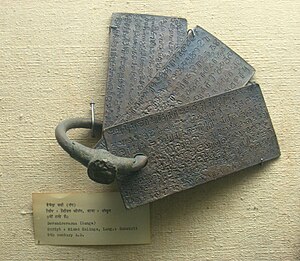
Back कलिंग लिपि ANP Kalinga (kirjoitusjärjestelmä) Finnish カリンガ文字 Japanese Alfabeta calinga LFN କଳିଙ୍ଗ ଲିପି OR కళింగ లిపి Tegulu อักษรกลิงคะ Thai
This article needs additional citations for verification. (June 2015) |
| Kalinga script | |
|---|---|
 Devendravarma (Ganga), Sanskrit in Mixed Kalinga script, 9th century AD. Copper plates, exhibited in the National Museum, New Delhi, India | |
| Script type | |
Time period | c. 600 - 1100 CE[1] |
| Languages | Odia language |
| Related scripts | |
Parent systems | |
Sister systems | Siddham, Sharada, Tibetan, Bhaiksuki |
The theorised Semitic origins of the Brahmi script are not universally agreed upon. | |
| Brahmic scripts |
|---|
| The Brahmi script and its descendants |
The Kalinga script or Southern Nagari[2] is a Brahmic script used in the region of what is now modern-day Odisha, India and was primarily used to write Odia language in the inscriptions of the kingdom of Kalinga which was under the reign of early Eastern Ganga dynasty.[1] By the 12th century, with the defeat of the Somavamshi dynasty by the Eastern Ganga monarch Anantavarman Chodaganga and the subsequent reunification of the Trikalinga(the three regions of ancient Odra- Kalinga, Utkala and Dakshina Koshala) region, the Kalinga script got replaced by the Siddhaṃ script-derived Proto-Oriya script which became the ancestor of the modern Odia script.[3][4][5]
- ^ a b Diringer, David (1948). Alphabet a key to the history of mankind. Hutchinson.
- ^ Tripathī, Kunjabihari (1962). The Evolution of Oriya Language and Script. Utkal University. p. 28. Retrieved 21 March 2021.
Southern Nāgari (Cf. The later Kalinga script of Bühler)
- ^ Cardona, George; Jain, Dhanesh (2003). The Indo-Aryan Languages. Routledge language family series. London: Routledge. p. 487. ISBN 0-7007-1130-9.
- ^ Tripāṭhī, Kunjabihari (1962). The Evolution of Oriya Language and Script. Utkal University. p. 32. Retrieved 21 March 2021.
- ^ Ancient Kalinga script. Archived from the original on 2018-01-21.
© MMXXIII Rich X Search. We shall prevail. All rights reserved. Rich X Search